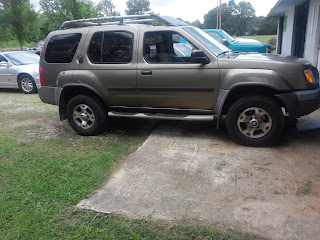A site that deals with automotive drivability, electrical, and general repair problems. Diagnostic procedures, DTC's, wiring diagrams, and many other issues and techniques will be shown and discussed. Hope you enjoy!
Wednesday, June 10, 2015
1998 Ford Explorer XLT 4.0, 2WD, Temperature Hand in Dash Inoperative
This 1998 Ford Explorer XLT 4.0, 2WD, came into the shop for a No Crank Concern. Once we found the issue there (a faulty Drive Belt Tensioner not allowing the Alternator to charge), we let the vehicle run to check the charge and the new battery we had installed.
As we let the vehicle run, we noticed the temperature hand in the dash was inoperative. The vehicle had reached normal operating temperature (after running for several minutes) but the hand was still below the "C" on the Temp gauge in the dash.
Below is a picture of the inoperative temp hand with the vehicle at normal operating temperature. The hand has obviously not moved and thus is inoperative for some reason.
The customer wanted us to find and fix the problem.
First, we needed to do some testing to see if it was the gauge in the dash that was faulty, the circuitry or the sensor under the hood. In order to see which it was, we had to disconnect the temp sensor. It is located in the thermostat housing (black plastic assembly).
With it unplugged, I jumped the the circuit to Battery (-). In the picture below you can see my jumper wire connected at the negative battery post on the battery.
Next, I put a probe gently into the connector for the temp sensor, so as to jump the circuit. If the circuitry (the wiring) from the connector to the gauge was good . . . and, if the gauge in the dash itself was good, this test would prove that because the hand in the dash should move all the way to the "H" position or even a little past.
In the next pic is a shot of the probe placed gently in the connector and the jumper wire connected to it.
The word gently is important here. The probe should never be forced or jammed into the connector. This could ruin that terminal of the connector.
Now, with the circuit jumped, we looked at the dash to see if the hand had moved or not. Below you will see the evidence.
Now we saw that the temp hand had moved all the way past the "H" mark on the gauge. This told us two valuable things: first, the circuitry (wiring) from the temp sensor connector all the way to the gauge was good; and second, the gauge in the dash was also good.
This one simple test ruled out two of the three possibilities and left us with the conclusion that the temp sensor was faulty and needed replacing. After replacing the sensor (we actually had to replace the entire t-stat housing because the sensor could not be removed from the housing: the boss (threads) had come loose and was turning with the sensor. I have another post about replacing the t-stat housing on a Mustang) the gauge in the dash now worked as it was designed to do.
We filled the coolant system up with coolant and gave it a test drive.
In the picture below is the temp hand operating normally with the vehicle running at normal operating temperature.
Another job was completed and we shipped the vehicle. The test was quick and easy and saved us a lot of time from guessing at what "might be" wrong to find what "definitely" was wrong. This is why the old adage says, Test . . . don't guess!
Friday, June 5, 2015
2001 Nissan Xterra 3.3 2WD, Noise When AC is On (Fan in Dash Making a Noise)
This 2001 Nissan Xterra 3.3, 2WD, came into the shop for an oil service and a customer concern of noise when she would turn on her AC.
Verifying the concern, we could hear the blower motor making noise as it ran at all speeds. We set out to remove the motor to find out what was causing the noise. We suspected napkins or papers from the glove box.
First, we opened the glove box and removed the contents. On this model, to gain access to the blower motor you must remove the glove box. There are 6 Phillips screws that hold the glove box in place.
Remove these six screws.
Once the 6 screws/fasteners are removed, the blower motor is in plain view.
Next, we removed the 3 screws/fasteners that hold the blower motor in place.
When we removed the blower motor, here is what we found inside the fan assembly. I would say this would cause a bit of noise!
And, another view.
We made sure there was no more debris/trash in the housing where the fan sits. Below is a view of this chamber from the bottom looking up.
And another view of the same, from a slightly different angle and with the flash turned on, so it's easier to see.
Once that was done, we re-installed the blower motor. We then tested it to make surer it was quiet and it was. (We also went ahead and replaced the two cabin air filters while we were in the space, but we did not take photos of that procedure.)
We got it all back together and the fan now runs quietly on all speeds.
Subscribe to:
Posts (Atom)














